A preliminary study into the use of ‘heat pipes’ to prevent high rigor temperature in beef carcasses by increasing cooling rate
Robin H. Jacob A E , David T. Beatty B C and Robyn D. Warner DA Department of Agriculture and Food WA, 3 Baron-Hay Court, South Perth, WA 6151, Australia.
B Formerly Murdoch University, South Street, Murdoch, WA 6150, Australia.
C Meat and Livestock Australia, Building East 1, Office No. E313, Dubai Airport Freezone, Dubai, United Arab Emirates.
D CSIRO Animal, Food and Health Sciences, 671 Sneydes Road, Werribee, Vic. 3030, Australia.
E Corresponding author. Email: robin.jacob@agric.wa.gov.au
Animal Production Science 54(4) 504-509 https://doi.org/10.1071/AN13001
Submitted: 2 January 2013 Accepted: 23 January 2014 Published: 6 March 2014
Journal Compilation © CSIRO Publishing 2014 Open Access CC BY-NC-ND
Abstract
Three experiments were conducted to investigate the use of a custom-made heat pipe to reduce muscle temperature in beef carcasses during the initial part of the refrigeration period post slaughter. The effects of muscle depth (Experiment 1) and radial distance from a heat pipe (Experiment 2) were investigated initially. Then the use of multiple heat pipes was compared with no heat pipes for the loin and hind leg regions of a carcass (Experiment 3). All three experiments were conducted at a commercial beef abattoir in Western Australia. Without heat pipes, the time taken for the temperature to fall to 35°C in the hind leg was 10, 90 and 300 min for depths of 25, 50 and 100 mm from the surface, respectively. Temperature increased with radial distance from a heat pipe and the relative differences in temperature between different positions increased with time. Temperatures 110 min after the commencement of cooling were 35.7, 36.8 and 38.3°C for 20, 40 and 80 mm from the heat pipe, compared with 39.8°C without the pipe. The loin cooled faster than the rump, which cooled faster than the leg. Heat pipes increased the rate of temperature loss in the leg but not the loin. The time taken for the leg temperature to reach 35°C, measured at a depth of 100 mm, reduced from 150 to 76 min. These experiments confirm that heat pipes containing methanol could be used to increase the rate of heat loss from leg muscles in beef carcasses. Further work is required to determine if the magnitude of these increases in cooling rate would improve eating quality for large carcasses.
Introduction
Heat pipes could provide a method to increase the rate of heat loss from specific locations in a beef carcass early in the post-slaughter period. Meat has a low coefficient of thermal conductivity (Van Moeseke et al. 2001) and heat pipes are a way of increasing the rate of heat loss from low conductivity materials (James et al. 2005). Deep muscles in heavy carcasses are predisposed to the conditions of high temperature (>35°C) and low pH (<6) associated with the negative effects on meat quality known as high rigor temperature (Warner et al. 2014b). Targeting these muscles for intervention rather than the whole carcass could provide a solution for high rigor temperature under commercial conditions with cold deboning. The temperature and pH conditions that cause high rigor temperature occur in the first 5 h post slaughter (Jacob and Hopkins 2014), before carcass breaking for a cold deboning operation.
Invented in 1963 by nuclear physicist George Grover (patent US3865184), heat pipes utilise the latent heat of vaporisation to move heat energy. They consist of a hollow, evacuated metal pipe that contains a fluid. Initially in the liquid phase, the fluid evaporates upon gaining heat at one end of the pipe exposed to a hot environment; the gas phase moves to the other end exposed to a cool environment, where it condenses releasing heat. The liquid phase then returns to the warm end of the pipe with the aid of gravity (thermosyphon), or by capillary action if the design includes a wick. In this way, heat is passed from one end of the pipe to the other at a faster rate than would otherwise occur in the material being cooled.
A heat pipe has an advantage compared with a solid conductor because energy can be carried by fluid convection in a heat pipe much more quickly than in (for instance) a copper rod of the same dimensions. In fact, heat pipes are ~500 times more effective than copper at transferring heat (James and James 1999). Various fluids can be used in heat pipes including water, methanol and ammonia; according to the boiling point of the fluid and the temperature range expected for the media to be cooled (James et al. 2005).
Heat pipes have previously been proposed as a way of reducing bone meat taint and bone marrow taint by accelerating the cooling rate of beef carcasses (Food Science Australia 1994). Other food applications explored for heat pipes have been to assist with heating and cooling cooked products including meat (Ketteringham and James 2000), and for freezing and thawing meat (James and James 1999). The overall aim of our study was to field test a custom-made heat pipe, at a commercial abattoir, for the purpose of mitigating high rigor temperature in beef carcasses. To do this we conducted three experiments designed to investigate; (1) the effect of depth from the muscle surface on temperature, (2) the effect of radial distance from a heat pipe within a muscle on temperature and (3) the effectiveness of a custom-made heat pipe to increase the rate of heat loss from various parts of a beef carcass.
Materials and methods
Experimental design
The experiment was conducted in collaboration with a commercial abattoir and this limited the choice of carcasses available to those of low value cows in Experiments 2 and 3.
Experiment 1
The aim was to compare the temperature measured at three depths; 25, 50 and 100 mm from the surface of the carcass. Six beef carcasses were selected at random from a consignment of grain-fed, highly marbled cattle slaughtered at a commercial abattoir in summer (18 January 2007). The mean hot carcass weight was 432 ± 7 kg (mean ± s.e.m.) and the average temperature of the loin muscle (M. longissimus thoracis et lumborum) at pH 6 was 34.5 ± 0.62°C (mean ± s.e.m.) using the Meat Standards Australia grading method (see Warner et al. 2014a). Temperature probes were placed in the fascial seam between the M. semitendinosus and M. semimembranosus when each carcass entered the chiller ~1 h post stunning. The carcasses were suspended in a commercial air chiller with air temperature in the range of 0−2°C. Temperatures were monitored for ~3 h subsequently.
Experiment 2
The aim was to compare temperatures measured at a depth of 100 mm from the carcass surface and at three distances radial to a heat pipe; 20, 40 and 80 mm, specifically to determine the placing of heat pipes in Experiment 3. One beef carcass was chosen at random at a commercial abattoir in spring (14 September 2007) with a hot carcass weight of 220 kg. A thermocouple was placed in the fascial seam between the M. semitendinosus and M. semimembranosus at a depth of 100 mm, for one side of the carcass (control) immediately on entry to the chiller, ~1 h post mortem. One heat pipe was placed in the same position of the corresponding leg from the opposite side, to a depth greater than 100 mm. Temperature probes were then placed in the muscle at distances of 20, 40 and 80 mm measured radially from the heat pipe, at a depth of 100 mm from the surface. The carcass was suspended in an air chiller with an air temperature set point of 0−2°C for the duration of the temperature monitoring period.
Experiment 3
The aim was to compare the rate of cooling in three different locations of a beef carcass with and without heat pipes. In total 24 carcasses were measured, consisting of six carcasses from cattle slaughtered each day for 4 days in summer (2, 5–7 November 2007). The first six carcasses from cows slaughtered at a commercial abattoir on each of the 4 days, were selected for this experiment. The heat pipes were inserted into the carcasses, just before entering a chiller ~1 h after stunning.
For each carcass, 10 heat pipes were placed in the left side only, leaving the right side with no heat pipes. In the left side, five heat pipes were placed in the loin (Fig. 1) at a spacing of two vertebrae between heat pipes with the first heat pipe being inserted at the level of the last lumbar vertebra. The pipes in the loin were inserted at an angle of ~20° to the horizontal to enable the pipes to function as directed by the manufacturer (see Fig. 1) and as deep as possible and this varied between locations depending on the muscle. Four pipes were placed in the leg, as shown in Fig. 2 and one pipe in the rump equidistant between the tubes in the leg and the last vertebra (see Fig. 2).
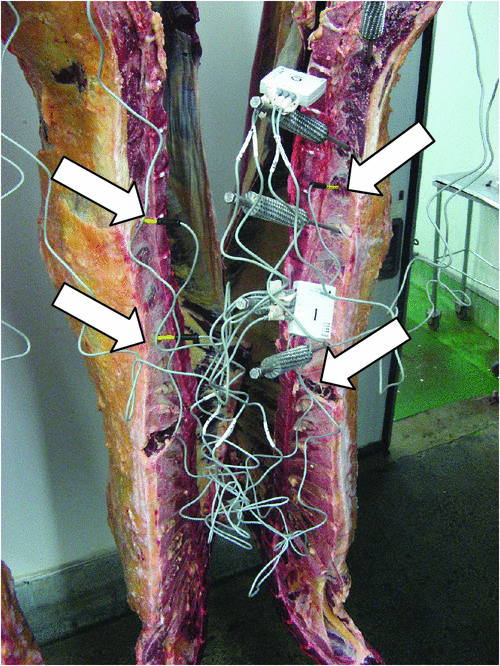
|
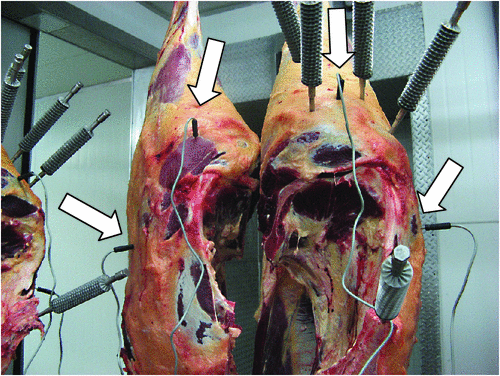
|
The carcasses were kept in an air chiller with air temperature in the range of 0−2°C for the duration of the temperature monitoring period. The carcasses had a mean weight of 234.8 ± 10.68 kg (mean ± s.e.m.), a P8 fat measurement (Anonymous 2000) of 25.9 ± 3.4 mm and all carcasses were from animals with a dentition score of 8. With no heat pipes, the mean estimated temperature of the loin at pH 6 was 21.9°C, using the Meat Standards Australia grading method (see Warner et al. 2014a).
Temperature and pH measurement
For Experiment 1, copper-constantan thermocouples were used to monitor muscle temperature. A block of three probes was made with three stainless steel 13-gauge needles, each containing a thermocouple at the tip. The needles were cut to lengths of 25, 50 and 100 mm to enable temperature measurement at each of these depths. Each needle was securely fastened to a copper-constantan plug and the plugs were joined together to make the block of three probes. Voltage output from the copper-constantan thermocouples was referenced to an iso-block on a DataTaker 500 (DataTaker, Scoresby, Vic., Australia) at 1-min intervals. Each thermocouple was calibrated using a certified (National Association of Testing Authorities, Australia, Rhodes, NSW) thermometer, mercury in glass type over the range 5−40°C.
For Experiments 2 and 3, temperature was monitored using HOBO U12 4-channel external data loggers (Onset Computer Corporation, Bourne, MA, USA) with TMC6-HC stainless steel temperature probes (Onset Computer Corporation) attached to each of the four external channels. Resolution of temperature loggers was 0.03°C. Stainless steel probes were 100 mm in length and 3 mm diameter. Each temperature probe was calibrated against a mercury-in-glass thermometer, certified by a National Association of Testing Authorities, Australia laboratory, over the range 5−40°C. For Experiment 3, four temperature probes were inserted into each side; two in the loin, one in the rump and one in the leg in the seam between the M. semimembranosus and M. semitendinosus to a depth of 100 mm. For the loin, one probe was placed in the lumbar region (high) and one in the vicinity of the thoracolumbar junction (low) to the depth of the muscle (~50 mm from surface and 100 mm from centre of vertabrae).
Muscle pH was measured using a TPS WP-80 m (http://www.tps.com.au, accessed 4 February 2014) attached to a glass probe electrode (Mettler Toledo LoT406-M6-DXK-S7/25, http://www.mt.com, accessed 4 February 2014) and calibrated with standard buffers. For Experiment 3, the pH of the M. semimembranosus was monitored on Days 1 and 2.
Heat pipes
The heat pipes were manufactured by Realcold Milmech (Coopers Plains, Qld, Australia). The heat pipes were 17 mm in diameter and 500 mm in length. They were made from stainless steel, filled to a level of 100 mm of the length with methanol, contained no wick; had an aluminium radial-finned section at one end and a pointed tip at the other end. The pointed tip end was inserted in the meat and the radial-finned section exposed to air.
Statistical analyses
Genstat version 10 (VSN International, Hemel Hempstead, UK) was used for all statistical analyses. In Experiment 1, the effect of time, depth of temperature probe and the interaction between time and depth were tested using a repeated-measures residual maximum likelihood (REML) procedure. The relationship between temperature probe depth and the time taken for the temperature to reach 35°C was tested using regression analyses. Data from Experiment 2 was from one carcass only so was of a descriptive nature, with no carcass variation to enable testing with statistical analyses.
For Experiment 3, a REML procedure was used to determine the effects of location, time and treatment on temperature. For the effect of logger location on temperature, the model was time, location and the interaction between time and location. For the effect of treatment on temperature, the fixed effects terms in the model were day, treatment, location and time. For this analysis, data from the rump was excluded due to missing data on Day 4. Carcass was used as a random term in both models. A paired t-test was used to compare pH values at the end of the chilling period.
Results
Experiment 1
Time and depth had significant effects on temperature (P < 0.01) and there was a significant interaction between time and depth (P < 0.01). At all time points the temperature for the probe at a depth of 25 mm was significantly lower than for the probe at 50 mm, which was significantly lower than for the probe at 100 mm (Fig. 3). The time taken for the temperature to reach 35°C was 10, 90 and 300 min for depths of 25, 50 and 100 mm, respectively.
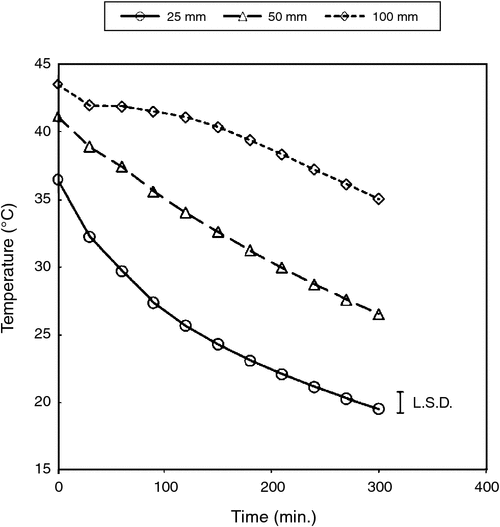
|
Experiment 2
There were differences in temperature between the control and heat pipe sides that depended on the time that the carcass had been in the chiller, as well as the distance from the heat tube. Except for the first time point, the temperature depended on the distance of the thermocouple from the heat pipe (Fig. 4). At any particular time point after the first, temperatures increased as the distance from the pipe increased from 20 to 40 and to 80 mm accordingly. The rate of change in the temperature difference compared with the control reduced after ~60 min (Fig. 5)
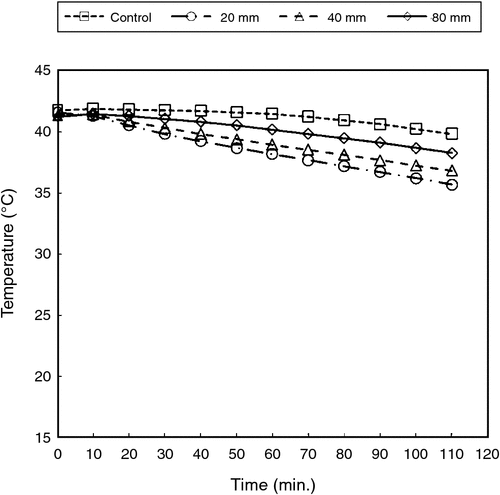
|
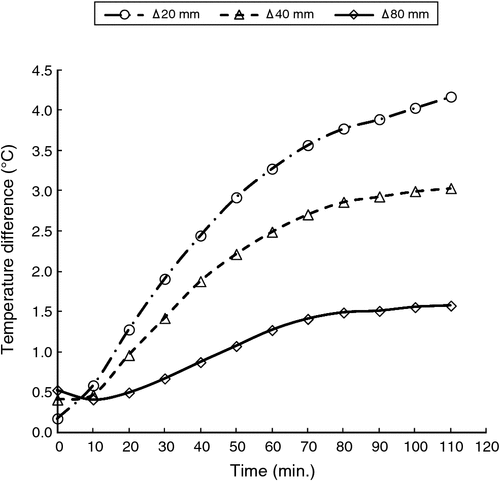
|
Experiment 3
The temperature was lower (P < 0.01) in the loin compared with the leg and rump at all time points. The mean temperature of the loin was below 35°C when temperature monitoring commenced (Fig. 6) and there was no difference in temperature between the two loin locations (low and high) at any time point. The temperature became lower in the rump compared with the leg 30 min after monitoring commenced at 1 h post slaughter. The time taken for the temperature to reach 35°C was 83 and 120 min after the commencement of monitoring for the rump and leg, respectively.
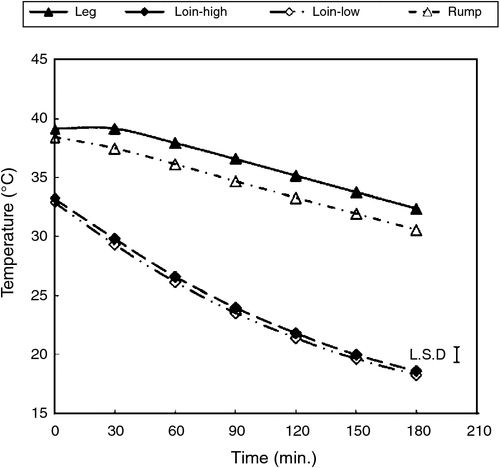
|
There was an effect of heat pipe treatment (P < 0.05) on temperature for the leg but not for the loin. Three hours after the start of monitoring, the difference in temperature between the two sides (no pipes versus pipes) was 1.13 and 4.03°C for the loin and leg, respectively (Fig. 7). In the leg the pipes decreased the time taken to reach 35°C by ~74 min from 150 to 76 min.
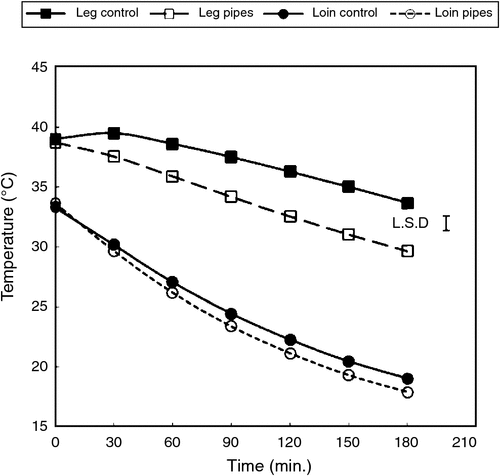
|
pH
The pH of the M. semimembranosus at the end of the temperature monitoring period for control and heat pipe sides was 5.82 ± 0.07 and 5.89 ± 0.07, respectively (values are means ± s.e.m.), and these values were not significantly (P > 0.05) different.
Discussion
The data from all three experiments support the proposition that beef carcasses are heterogeneous for rate of heat loss due to differences in dimensions and relative distributions of fat and lean. Fat has a lower thermal conductivity than lean muscle (Willix et al. 1998). The leg was much more susceptible than the loin to high rigor temperature. The temperatures measured in the leg of the ‘heavier’ carcasses remained in the range where high rigor temperature was a risk, for ~5 h after commencement of refrigeration. This would likely be associated with high rigor temperature conditions, although pH was not measured to confirm this. The low heat conductivity of meat is therefore a key component of high rigor temperature and strategies that focus on circumventing this issue are worthy of consideration for preventing high rigor temperature.
The rate of temperature change within a carcass clearly depends on the muscle and the depth at which measurements are taken, with the hind leg generally being accepted as the location to cool at the slowest rate (Pham et al. 2009). Taking measurements from the loin will likely underestimate the occurrence of high rigor temperature in the leg unless a relationship between the temperatures of the two muscles could be well defined. Such a relationship could be complex and depend on other factors such as carcass weight and fatness. Warner et al. (2014a) reported an incidence for high rigor temperature in the loin of beef carcasses in Australia to be 75% but this is likely to be much higher in leg muscles. Our results differ slightly from those of Stolowski et al. (2006) who observed that temperature change was slower for M. gluteus medius (rump muscle) than M. semimembranosus. Although we measured temperature in the leg seam and not the muscle directly, the temperature in the seam adjacent to the M. semimembranosus stayed above 35°C for 37 min longer than in the rump. These carcasses were derived from low value cull cows with a relatively low hot carcass weight (~235 kg) and most likely had smaller rumps with less intramuscular fat compared with those in the Stolowski et al. (2006) study, where the range in carcass weight was 302–333 kg.
Of the carcass locations tested, the loin was the least likely to have temperatures sufficiently high to induce high rigor temperature. Even in Experiment 1, the mean temperature when pH reached 6 was estimated to be ~34.5°C; just below the benchmark value of 35°C for high rigor temperature (Warner et al. 2014b). The carcass weights in Experiment 1 were in the range expected for grain-fed ‘Jap Ox’ cattle of 350–420 kg (Andrews and Littler 2008). Gruber Tatum Scanga Chapman Smith and Belk (2006) found that the change in shear force after aging depended on the muscle and the carcass grade but could be of a similar magnitude for both M. semimembranosus and M. longissimus dorsi. Preventing high rigor temperature conditions may therefore improve the tenderness of the leg muscles when aged, although proof of this would require further investigation.
The time that temperature stayed above 35°C, when measured at a depth of 100 mm in the leg seam, varied from 120 min in Experiment 3 to 300 min in Experiment 1. The mean hot carcass weight for Experiment 1 was 432 ± 7 kg compared with 234.8 ± 10.68 kg for Experiment 3 so this finding is consistent with the rate of temperature change being slower in larger carcasses.
Neither the application of heat pipes nor the position of the temperature probe changed the rate of cooling in the loin. One practical difficulty was to maintain a constant orientation for the pipe between the different locations in the carcass. The angles of the pipes in the loin were closer to the horizontal than those in the leg because it was more difficult to insert the pipes into this muscle without causing damage. This may have influenced the effectiveness of the pipes as they had no wick. However, this result was consistent with the findings of Stolowski et al. (2006) who found that loin cooled the fastest of seven muscles tested due to its shape and location. Additional cooling techniques are therefore likely to be required for the leg more so than for the loin, to avoid high rigor temperatures with conventional cooling systems. Strategies to avoid high rigor temperature in the loin may simply need to focus on the rate of heat loss from the surface rather than from deep within the muscle. Hot fat trimming and spray cooling are such techniques although studies to date indicate advantages for efficiency and yield but relatively little effect on rate of cooling for these methods (Hippe et al. 1991; Ahmed et al. 1992).Our results suggest that heat pipes may be beneficial for removing heat from beef legs and therefore minimise the effects of high rigor temperature in these muscles. Further investigation into the effects on eating quality attributes, such as water-holding capacity, colour stability and tenderness after aging, would be required to determine if they might also represent a commercial solution for high rigor temperature. Other factors such as the cost of pipes, maintenance, cleaning and labour to insert as well as the potential to cause physical damage and microbial contamination would need investigation also.
We acknowledge that collection of wind speed data was lacking in our design and that this should be included in any further validation experiments of heat pipes. However, the relationship demonstrated between radial distance from the heat pipe and temperature provides some indication of the distance between pipes required to increase the rate of cooling of muscles. The maximum thickness of 80 mm proposed for very fast chilling (Van Moeseke et al. 2001) probably also applies to heat pipes given the data in Fig. 4. Heat pipes effectively prevented the period of temperature inertia at the commencement of chilling and halved the time taken for the temperature to fall below 35°C in the leg seam (Fig. 7). Combination with other techniques such as partial hot fabrication techniques (Meade et al. 1992) and ‘stifling’, as recommended for preventing bone taint (Food Science Australia 1994), may also be worthy of investigation.
Conclusions
Temperature, as part of a quality assessment procedure, should be measured in the hind leg as well as the loin, and temperature probes should be placed at a depth of at least 100 mm to detect high rigor temperature conditions in beef carcasses. Expediting heat conduction in beef muscle is a key aspect of reducing high rigor temperature. Heat pipes can increase the rate of heat loss from deep within the hind leg muscles of beef carcasses during refrigeration. Radial distances between heat pipes are important and the heat pipe should penetrate the meat to a depth greater than 100 mm. Heat pipes likely have limited value for loin muscle as the temperature may fall at a sufficient rate to avoid high rigor temperature without them.
References
Ahmed PO, Miller MF, Shackelford SD, Johnson LP, Williams SE, McCann MA, Reagan JO (1992) Effect of hot-fat trimming on factors associated with the subprimal yield of beef carcasses. Journal of Animal Science 70, 439–443.Andrews T, Littler B (2008) ‘Market specifications for beef cattle.’ (NSW Department of Primary Industries: Orange)
Anonymous (2000) ‘Advanced carcase fat measurement, (ACFM), bovine P8, participant’s workbook.’ (AUS-MEAT Limited: North Murarrie, Qld) Available at http://www.ausmeat.com.au/media/1728/20150-acfm%20bovine%20workbook%202000.pdf [Verified 27 February 2014]
Food Science Australia (1994) ‘Appraisal of techniques for assisting the cooling of beef carcases.’ Australian Meat Technology Meat Research Letter. (Australian Meat Technology: Cannon Hill) Available at http://www.meatupdate.csiro.au/data/MEAT_TECHNOLOGY_UPDATE_95-6.pdf [Verified 27 February 2014]
Gruber S, Tatum J, Scanga J, Chapman P, Smith G, Belk K (2006) Effects of post mortem ageing and USDA quality grade on Warner-Bratzler shear force values of seventeen individual beef muscles. Journal of Animal Science 84, 3387–3396.
| Effects of post mortem ageing and USDA quality grade on Warner-Bratzler shear force values of seventeen individual beef muscles.Crossref | GoogleScholarGoogle Scholar | 1:CAS:528:DC%2BD28Xht1CnurbI&md5=29d5a31404083d656231b8582d92e47dCAS | 17093232PubMed |
Hippe CL, Field RA, Ray B, Russell WC (1991) Effect of spray-chilling on quality of beef from lean and fatter carcasses. Journal of Animal Science 69, 178–183.
Jacob RH, Hopkins DL (2014) Techniques to reduce the temperature of beef muscle early in the post mortem period – a review. Animal Production Science 54, 482–493.
| Techniques to reduce the temperature of beef muscle early in the post mortem period – a review.Crossref | GoogleScholarGoogle Scholar |
James C, James S (1999) The heat pipe and its potential for enhancing the freezing and thawing of meat in the catering industry. International Journal of Refrigeration 22, 414–424.
| The heat pipe and its potential for enhancing the freezing and thawing of meat in the catering industry.Crossref | GoogleScholarGoogle Scholar |
James C, Araujo M, Carvalho A, James S (2005) The heat pipe and its potential for enhancing the cooking and cooling of meat joints. International Journal of Food Science & Technology 40, 419–423.
| The heat pipe and its potential for enhancing the cooking and cooling of meat joints.Crossref | GoogleScholarGoogle Scholar | 1:CAS:528:DC%2BD2MXjsValtbo%3D&md5=91fe5d24a11a7fb08dca1ff501cbc655CAS |
Ketteringham L, James S (2000) The use of high thermal conductivity inserts to improve the cooling of cooked foods. Journal of Food Engineering 45, 49–53.
| The use of high thermal conductivity inserts to improve the cooling of cooked foods.Crossref | GoogleScholarGoogle Scholar |
Meade MK, Johnson DD, West RL (1992) Physical and sensory characteristics and microbiological quality of beef from a partial hot fabrication procedure. Journal of Food Science 57, 1041–1044.
| Physical and sensory characteristics and microbiological quality of beef from a partial hot fabrication procedure.Crossref | GoogleScholarGoogle Scholar |
Pham QT, Trujillo FJ, Davey LM, McPhail N (2009) Cooling curves for the preliminary design of beef chillers. International Journal of Refrigeration 32, 1944–1953.
| Cooling curves for the preliminary design of beef chillers.Crossref | GoogleScholarGoogle Scholar |
Stolowski GD, Baird BE, Miller RK, Savell JW, Sams AR, Taylor JF, Sanders JO, Smith SB (2006) Factors influencing the variation in tenderness of seven major beef muscles from three Angus and Brahman breed crosses. Meat Science 73, 475–483.
| Factors influencing the variation in tenderness of seven major beef muscles from three Angus and Brahman breed crosses.Crossref | GoogleScholarGoogle Scholar | 1:STN:280:DC%2BC3MbnsV2ktQ%3D%3D&md5=8b8bfa7de9af3200471e4b4fc9326dfaCAS | 22062486PubMed |
Van Moeseke W, Smet SD, Claeys E, Demeyer D (2001) Very fast chilling of beef: effects on meat quality. Meat Science 59, 31–37.
| Very fast chilling of beef: effects on meat quality.Crossref | GoogleScholarGoogle Scholar | 1:STN:280:DC%2BC3MbnsV2qsg%3D%3D&md5=a7ac54a272a4cfa8fc655dc9289c7309CAS | 22062503PubMed |
Warner RD, Dunshea FR, Gutzke D, Lau J, Kearney G (2014a) Factors influencing the incidence of high rigor temperature in beef carcasses in Australia. Animal Production Science 54, 363–374.
| Factors influencing the incidence of high rigor temperature in beef carcasses in Australia.Crossref | GoogleScholarGoogle Scholar |
Warner RD, Thompson JM, Polkinghorne R, Gutzke D, Kearney GA (2014b) A consumer sensory study of the influence of rigor temperature on eating quality and ageing potential of beef striploin and rump. Animal Production Science 54, 396–406.
| A consumer sensory study of the influence of rigor temperature on eating quality and ageing potential of beef striploin and rump.Crossref | GoogleScholarGoogle Scholar |
Willix J, Lovatt SJ, Amos ND (1998) Additional thermal conductivity values of foods measured by a guarded hot plate. Journal of Food Engineering 37, 159–174.
| Additional thermal conductivity values of foods measured by a guarded hot plate.Crossref | GoogleScholarGoogle Scholar |


